While wheat varies in growth stage across Tennessee, it’s time to consider fungicide and scout for diseases. To date, little to no disease has been reported in wheat fields in Tennessee.
It’s well known cutting input costs is a big topic this year across all cropping systems and wheat is no exception, nor is fungicide. As always, UTcrops.com has resources that can help growers make the decision on fungicide application in wheat, including the Wheat Foliar Fungicide Point System (tiny.utk.edu/WheatFungPointSys). While only a little powdery mildew (Image 1) and leaf/glume blotch (Image 2) (Septoria and/or Stagonospora blotch) has been reported, scouting to see what diseases are present in your field is the first step. To help with disease identification short descriptions of fungal wheat diseases which include conditions for disease development, symptoms and specific management options can be found along with images in the Fungal Wheat Disease Identification publication (tiny.utk.edu/WheatDiseaseID). Additionally, general disease scouting time line and guidance on timing of fungicide can be found in the UT Extension Wheat Disease Management publication (tiny.utk.edu/WheatDiseaseManage) and Wheat Fungicide Efficacy Table (tiny.utk.edu/WheatFungEfficacyTable and https://cropprotectionnetwork.org/publications/fungicide-efficacy-for-control-of-wheat-diseases).
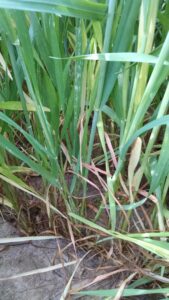
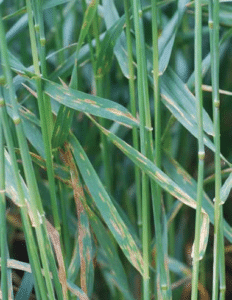
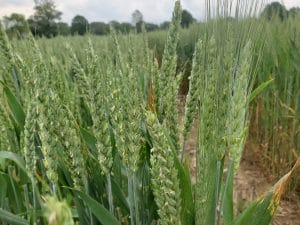
Many fields are in bloom or will be soon, and this is the highest period of susceptibility to scab/FHB infection. While wheat is susceptible to infection from head emergence until harvest, infections initiated at and soon after bloom have the greatest destructive potential. FHB/Head Scab infection is favored by extended periods of moisture (3 or more days with frequent rainfall) or relative humidity (>90%) and moderately warm temperatures (between 59 to 86°F). These conditions present before, during, and after bloom favor spore production, flower infection, and colonization of developing grains.
Research has shown the most effective timing for controlling FHB and mycotoxin levels is at initial bloom/flowering (Feekes 10.5.1), which relates to at least 50% of the heads blooming in a field (Image 3). Although applications made 5 to 6 days after initial bloom can also provide a benefit in reducing FHB and mycotoxin levels.
The FHB Prediction Center (http://www.wheatscab.psu.edu/) uses models to estimate Head Scab/FHB risk using weather variables and one can customize the model predictions by picking variety susceptibility (from Very Susceptible, Susceptible, Moderately Susceptible, and Moderately Resistant to Head Scab), in menu in the upper left. While risk is estimated to be low across most of Tennessee for ‘susceptible’ varieties (Fig. 1), those using very old varieties should change the model to ‘very susceptible’ and consider the higher risk in that map (Fig. 2). Similarly, the scattered showers within the 10-day window recently will increase risk and might not be captured in the ‘susceptible’ variety model.
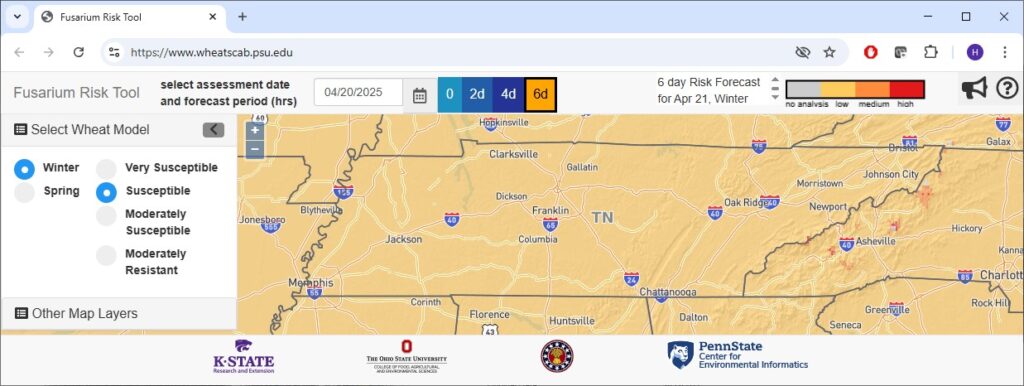
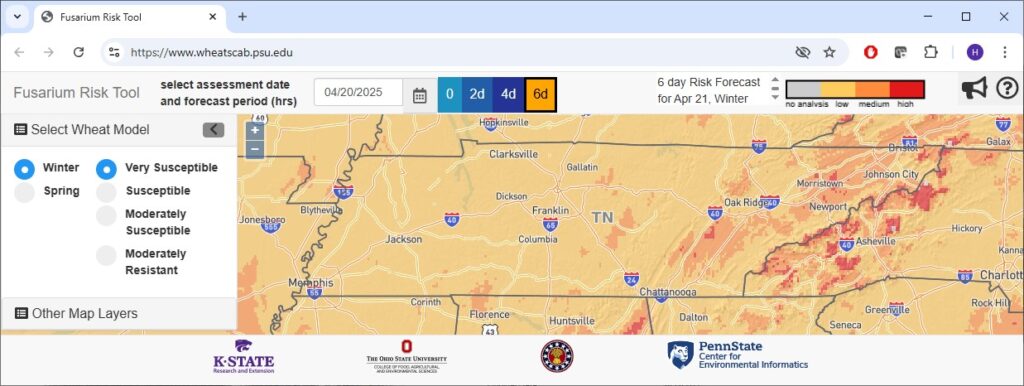
Fungicide products that contain a strobilurin (FRAC or fungicide group 11) can increase the mycotoxin levels in FHB infected wheat and hence should not be applied after heading. Consider protecting wheat from scab/FHB and use the fungicide efficacy table to choose the right product for your situation Wheat Fungicide Efficacy Table (tiny.utk.edu/WheatFungEfficacyTable and https://cropprotectionnetwork.org/publications/fungicide-efficacy-for-control-of-wheat-diseases).
Although these fungicides, like all fungicides, are not going to provide 100% control, research trials have shown that FHB symptoms and DON levels can be reduced by approximately 40-60% relative to a non-treated check. Multiple factors contribute to this level of control which include fungicide efficacy, application coverage, timing in respect to wheat growth stage (all the heads in a field will not be flowering at the same time), and disease risk (i.e. weather before, during, and after application as well as previous crop – wheat after corn = higher risk).
Final note on Head Scab management, while fungicides can reduce disease and mycotoxin levels in wheat, the pairing of fungicide with a tolerant Head Scab/FHB variety will provide the best protection. More information, including variety susceptibility/tolerance to Head Scab can be found at scabsmart.org.

